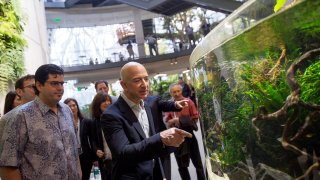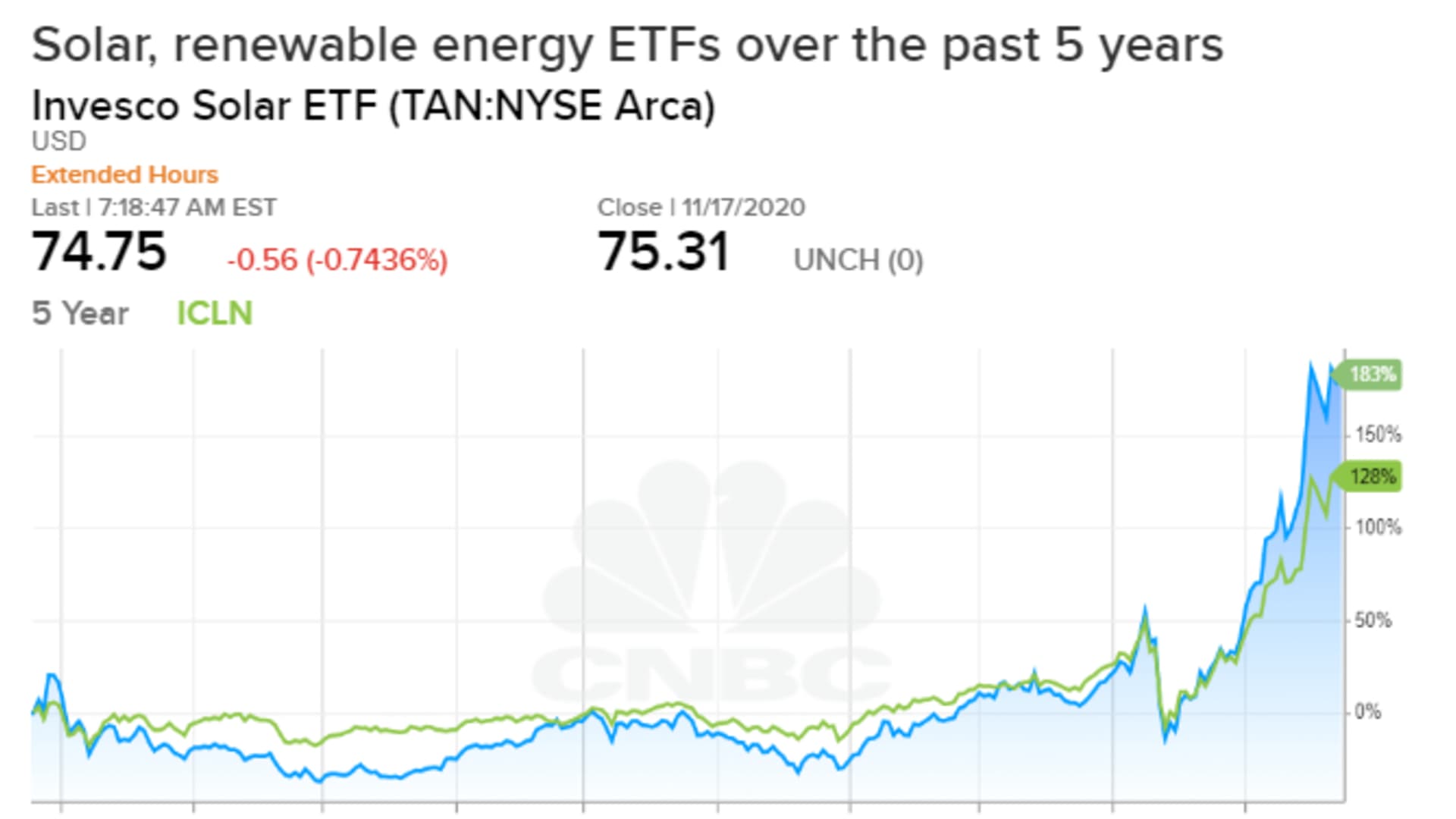
- Jeff Bezos just announced the first grants from a planned $10 billion climate change fund, and Elon Musk's electric vehicle and renewable energy company Tesla is to become the largest-ever added to the S&P 500.
- Climate is a fundamental investment theme quickly filtering down through the ranks of the wealthy and far below the level of billionaires.
- With trillions of dollars in economic activity expected in the years ahead, letting the politics of climate get in the way of investments is being seen by affluent investors as a mistake.
Amazon's Jeff Bezos just named the first recipients of his $10 billion climate fund. Elon Musk's electric vehicle and renewable energy company Tesla is poised to become the largest company ever added to the S&P 500. At its current market cap, Tesla is bigger than the five largest companies in the S&P 500 energy sub-sector combined. But the attention that the world's wealthy are paying to climate change is far more widespread than just at the level of the market's billionaires. There is a saying that you should keep your politics out of your pocketbook, and that is increasingly the case for wealthy investors when the issue is climate change. They are looking at the numbers and see an investing imperative rather than point of divisive debate.
Michael Sonnenfeldt, the entrepreneur who heads Tiger 21, an investment club for the ultra-wealthy, has spent a lot of time over the years at his alma mater, working with the MIT Sloan Management School and climate modelers on the Climate Pathways project, which he helped found. One of its primary goals is to demonstrate to bipartisan elected officials and business leaders what climate data means in terms of real-life consequences.
After the past few years working with the MIT climate project, and showing the data to many elected officials on both sides of the aisle, Sonnenfeldt said it became clear the models were not just showing climatology, but identifying where major opportunity sets exist in the investment world. "It became clear to me, there are real opportunity sets around climate, whether you believe in it or not."
Covid-19 and climate
It has only been in the last six months that his investment club formalized an approach to climate as a new investing mega-theme. As he tells members of Tiger 21's new climate investing group, you don't have to believe in climate change to know it is going to transform economies.
Tiger 21 has many members in Canada, as well as Dallas and Houston, where fortunes have been made feeding off natural resources, but Sonnenfeldt said that in these regions investors can't ignore that it is the oil and gas sector in distress and renewables now look like long-term assets.
Money Report
Covid-19 has helped to trigger this investment awakening. The investment club for the wealthy used to be centered on in-person meetings, but that has changed amid Covid-19, and the move to virtual groups of Tiger 21 investors with similar interests, no matter where they are based, was among the factors that led to the formation of a climate investing group in earlier this year.
"The changes are underway and it doesn't matter what your politics are," Sonnenfeldt said. "Renewables are simply cheaper than fossil fuels and the energy complex across the U.S. and Europe sees utilities shifting in buying patterns. Regardless of personal views ... the opportunities are exploding. It is not just Tesla, but all of solar," he said.

Some market strategists have noted that the incredible run this year in sectors such as solar and utilities, as well as Tesla, may have been trades based on belief in a so-called "blue wave" of Democrats sweeping into office and a President Biden possessing the political capital to undertake a large green energy stimulus.
"Our view is that even in a status quo environment there is strong momentum, from sub-national levels of government and from corporates, to focus on climate and renewables, and the investment case doesn't change that much based on the outcome of the election," said Andrew Lee, head of sustainable and impact investing at UBS Global Wealth Management. "If you look at everything that is happening it still supports the case for renewables."
Lee cited policy spend on green rebuilding in the European Union and China's carbon neutrality goals in the coming decades as "very strong indications for investors" unrelated to short-term election outcomes in the U.S.
Solar, wind on track to pass natural gas, coal by 2024
There has been concern that at least in the short-term, the global pandemic will stall government stimulus related to climate, but a recent report from the International Energy Agency does not come to that conclusion. IEA Executive Director Fatih Birol said in a Nov. 10 webinar that while the energy system is having its worst year since the World War II, "Renewable energy appears to be immune to COVID-19."
This year will post the highest-ever share of newly built generation capacity for renewables, according to the IEA's annual outlook released earlier this month. As oil, gas and coal all decline, 200 gigawatts of renewable power will be added in 2020, led by China and the U.S., and the IEA estimates that renewables will represent close to 90% of all new power capacity. Reasons cited by the IEA included priority grid access and long-term subsidy support, but one short-term trigger as well, which is less bullish: expiring government incentives that need to be used before the opportunity is lost.
The IEA said while the policy uncertainty could weigh in the short-term, renewable growth will remain strong because solar and onshore wind are "already the cheapest ways of adding new electricity-generating plants in most countries today."
It projects that renewables will represent 95% of the net increase in global power capacity through 2025, and total installed wind and solar capacity surpass natural gas in 2023 and coal in 2024.
Concerns about the intermittent nature of renewable power generation sources remain, and are often cited by skeptics as a reason that solar and wind are not ready to assume a prominent role in power supply. But the climate models that Sonnenfeldt looks at, look beyond headlines pointing a finger at renewables in California power outages: any company whose valuation is based on assets and reserves that have not been properly adjusted for the notion of some being stranded have a much greater liability than worrying about the intermittency of the sun or wind. "Nextera assets depend on sun shining and wind blowing. ExxonMobil's on the assumption of what portion can be taken out of the ground and turned into profits," he said.
"Solar and wind are a much more mature opportunity now than 10 years ago, and when you combine that with where the cost curves have gone and cost-competitiveness, it's something long-term investors look at as a long-term theme running through the portfolio," UBS's Lee said. "There's always been opportunistic trading around these, but when we think about how longer-term investors are positioned and key themes, they are looking at this and it will increasingly run through many portfolios."
Sonnenfeldt views the opportunity as being global, and far from limited to the energy sector, or even stock market.
Within Tiger 21, among the investors with the most already invested in climate plays — he is among the club members that have "millions" already invested around climate themes — there are experts on public markets, debt markets, private equity and more specialized climate finance projects.
Many countries set zero-carbon goals and what's going to happen to meet those goals is the shuttering of fossil-fuel generation like coal plants and the building of renewable power plants and "100 other things" through restructured utilities, he said. The capital investment will include new wiring and power plant construction and electric grid revamps. Over the next decade, Sonnenfeldt said there will be on average $1 trillion to $2 trillion spent per year, $10 trillion to $20 trillion, total in capital expenditures related to climate.
"We see a wide palate of opportunities that can be expressed in the public and private market, through private equity and venture capital and public stock and debt," the investor said.
Climate and AI: Mega themes of the investing future
There are very few investable trends that are larger.
"You might think AI is bigger than renewables," Sonnenfeldt said, noting it is expected to add $15 trillion per year to the global economy over the next decade. That is a different measurement than the spending tied to climate, but taken together, AI and climate "may be the two largest investable trends within our eyesight," he said.
Climate investments are growing faster than AI investments, if not in absolute dollar amounts. Over the past seven years, total funding for climate tech companies, rate of start-up creation, and the average size of funding has continued to rise, according to a recent report from PWC. In 2013, the early-stage venture funding for climate tech companies was about $418 million. However, in 2019, total venture funding increased to $16.1 billion, a more than 3,750% increase, and that is three times the growth rate of VC investment into AI.
"I think what's happening this year in regards to renewable energy versus traditional energy is reflective of a thematic focus many investors have taken and a focus on thinking about transitions and how they want to be positioned," said Lee. Private bank investors are tilting their public stock portfolios to invest in the transition to renewables, or directly investing in private opportunities.
Lee said the recent stock market momentum for renewable stocks has attracted attention, but longer-term policy and regulatory frameworks across globe, whether at a national or sub-national level, underscore a long-term investment rationale behind both renewables and a broader "green" portfolio of companies. Direct investments come, "with concentration risk," Lee said, but he added, "think about disruptive companies looking to directly address climate change, like carbon removal. Go beyond renewables and think about all of the other areas where there are implications or opportunities from a climate perspective. Everything from innovation in farming to biotech around the food revolution, use of satellite imagery to optimize food production."
The broader investing theme of ESG (environment, social and governance) remains under political scrutiny, with major parts of the U.S. government including the Securities and Exchange Commission and Department of Labor questioning the concept as a legitimate investing process. But Sonnenfeldt looks at the "E" and sees no legitimate counter-argument from the investing skeptics.
"ESG is not hazy if you're closing a coal plant and replacing it with solar, and you have to lay new wires to get power to the grid and might need to invest in wiring and electricians and infrastructure and real estate. It all translates into the magnitude of what this is," he said. And climate is on a clock: it requires reducing CO2 within a specific time period and that requires policy applications and capital allocations.
Another example that shows the breadth of the opportunity and legacy sectors that have a large, if complicated, role to play: the metals and commodities that will be required.
Energy sector consultant Wood Mackenzie expects more than $1 trillion of investment will be needed in key energy transition metals — aluminium, cobalt, copper, nickel and lithium — over the next 15 years just to meet the growing demands of decarbonization. That is roughly double the figure invested over the previous 15 years.
"Put simply, the energy transition starts and ends with metals. If you want to generate, transmit or store low/no-carbon energy you need aluminium, cobalt, copper, nickel and lithium," the firm said in a recent analysis.
Climate and portfolio risk
There's another side to the climate investing opportunity: the risk posed by climate change to investor portfolio holdings.
UBS's Lee said private investors recognize that climate change is one of the most significant risks and opportunities that they need to think about in portfolios, and it is relevant across asset classes, sectors and geographies from both the positive potential and risk perspectives.
The Federal Reserve has recently been more vocal about the need to assess climate risks to the financial system. The CTFC recently released its first-ever report on climate and the markets. In Europe, companies are now being required to identify climate risks, and Lee said it is likely that in future years investment statements in the U.S. highlight climate risks to clients of financial firms, and more investors want that information.
"Private investors have become much more attuned to the fact that there are implications across their portfolios, whether direct implications of energy exposure and how it will change in a multi-decade transition, and who is well-positioned for that, and who is not."
"It is a tilt towards the set of companies that are prepared for the transition, as opposed to a binary in or out," Lee said. "It is across sectors, which companies are prepared and which are incorporating the risks ahead from the environment ... That's a portfolio discussion."
Among UBS clients, the conversation is going beyond climate to a broader adoption of ESG and mega-themes for the future of investing that include food and food waste, global population issues, and inequality.
"Investors are focused on having portfolios in underlying solutions that reflect ESG considerations being factored in on a regular basis," Lee said. "Some are focusing on the climate opportunity and exposure to that, but I think we've seen such a broad move and interest from our clients, in particular, to ensure that all ESG factors and risks broadly are incorporated into portfolio analysis. ... All those factors do affect investment returns, and where material and relevant, they should be factored in. Ultimately, an investment portfolio is a tool to use capital to generate returns, and also factor in ESG in generating returns," the UBS official said.
The UBS executive said while academic research is growing which shows a focus on ESG issues can lead to company outperformance over longer period of time, looking asset class by asset class or sector by sector, there is enough evidence that "comparable performance" is being achieved, and that is the case for development bank bonds compared to U.S. treasuries, or broad equity indexes that have performed in line or better on a risk-adjusted basis than traditional indices.
Lee said that the goal does not need to be outperformance of traditional portfolios, but "comparable performance," which is the benchmark used by UBS.






